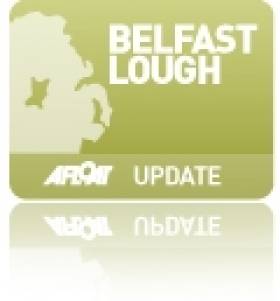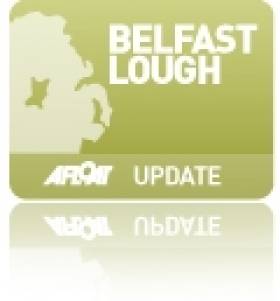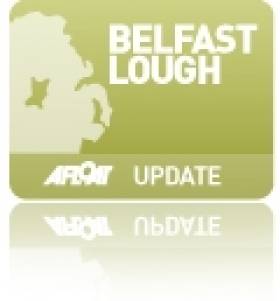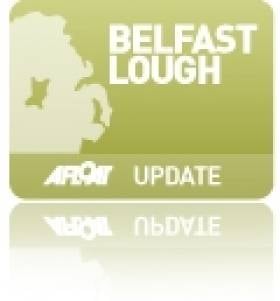Displaying items by tag: Belfast Lough News
Giant 'Dolphin' Oil Rig Not Leaving Ulster Just Yet
#OilRig – The Newsletter reports that the industrial behemoth that is an oil rig at Harland & Wolff, is set to remain as part of the skyline of Belfast for a number of weeks to come.
As previously reported on Afloat.ie, the enormous Blackford Dolphin drilling rig which made its way from Brazil last year, is currently in dry dock at Harland and Wolff as part of a re-fit project involving more than 1,000 workers.
The original contract to complete the work began last year and had run its course by around mid-February. However, she is still in the yard, and likely to stay put for at least another month. To know why, the Newsletter has more on this story.
Belfast Harbour Trade Figures 'In The Black'
#BelfastHarbour -Belfast Harbour's trade rose by 16% during 2013 with record tonnages of almost 23 million passing through the port.
Over half the increase, 1.7m tonnes, was fuelled by an increase of over 150% in coal imports. This reflects a new service through Belfast to supply AES Kilroot power station which generates c.30% of Northern Ireland's electricity.
Overall, Dry Bulk cargoes, vital to Northern Ireland's agri-food and quarry industries, increased by 45% to a record 6.744m tonnes. Growth was also positive in other sectors such as Liquid Bulk (primarily petrol and diesel) which was up 2% to 2.173m tonnes, and freight traffic, up 8% to a record 466,000 vehicles during the year.
Break Bulk tonnages rose by 57% to 452,000 tonnes, driven by the Harbour's new offshore wind terminal operated by DONG Energy and Scottish Power Renewables. Trade in wind farm components rose from just 3,000 tonnes in 2012 to over 200,000 tonnes last year.
Roy Adair, Belfast Harbour's CEO, said: "2013 has been a very positive year for Belfast Harbour as the economy started to recover slowly and investments in new facilities began to come online. Coal tonnages have been particularly impressive following capital expenditure in new deep water facilities.
"Likewise, Belfast's £50m investment in the UK's first bespoke logistics and assembly harbour to support offshore renewables is supporting significant growth in an industry which is benefitting not just Belfast Harbour, but the wider Northern Ireland economy.
"Major investments by Stena Line in new terminals and vessels is also encouraging growth, with increased traffic on all of Stena's routes from Belfast to Cairnryan, Heysham and Liverpool.
"Tonnages are now 30% up on the pre-recession peak of 2007. Belfast Harbour remains committed to identifying new capital expenditure projects and initiatives to support further growth in tonnages and in the local economy."
Northern Ireland's Minister for Regional Development, Danny Kennedy MLA, added: "The release of these figures clearly demonstrates the significant economic contribution that Belfast Harbour continues to make to Northern Ireland in terms of connectivity, jobs and the local economy. These figures, together with the recent investment in DONG Energy and other ongoing projects, underlines the commitment of the Port to achieving the Executive's Programme for Government priority to grow the economy."
In addition to coal and wind farm components other bulk trades also grew strongly over the year. Record years were achieved in scrap and stone tonnages, both rising by 28% to 327,000 tonnes and 1.22m tonnes respectively, while fertiliser imports rose 31%. Animal feeds and grains rose 2% to 2.09m tonnes, a record year reflecting the continuing strength of the local agri-food sector.
Joe O'Neill, Belfast Harbour's Commercial Director, said: "2013 has been a particularly good year due to a number of major, long term investments by Belfast Harbour coming to fruition simultaneously. In recent years the three trades which led growth in 2013 - renewables, coal and freight – have benefitted from dedicated capital expenditure by the Harbour totalling c.£100m.
"Trades are, however, always cyclical and the harbour will continue to seek new commercial opportunities and investments to help future-proof the business."
During 2013 Belfast Harbour also noted a 2% rise in passenger numbers to 1.4m, the highest figure since 2004. 59 cruise ships also called at the port bringing 105,000 passengers and crew.
Repairs Start on Belfast's Warship Caroline
#WWICruiser –Repairs to vital weatherproofing have started on HMS Caroline in advance of major restorative work to turn the famous World War One fighting ship as previously reported into a floating museum in Belfast.
It came dangerously close to sinking during the big freeze of 2010 when pipes and radiators burst, but work is well under way to protect it from the ravages of another potential harsh winter.
Deck timbers are being replaced to prevent the risk of more flooding and a major internal inspection of space below the water line is being carried out. For more The Belfast Telegraph reports.
Belfast 400 Years of Maritime History Exhibition
#Belfast400 – Belfast's 400 years of maritime history is being recognized with a new exhibition.
The News Letter which has more reports that the new heritage space 'A Port that Built A City' in Belfast Harbour details the city's emergence as a major port and its subsequent growth and development as an industrial hub.
Details of how the public can visit 'A Port that Built a City' will be made available early in the New Year through an online booking system. For photographs of the exhibition click this link.
Belfast Harbour Achieves High Standards in 'Green' Survey
#GreenPort – Once again Belfast Harbour has been named as one of Northern Ireland's top 'green' companies in a major environmental survey.
The harbour scored the second highest marks and was awarded Platinum quintile status in this year's NI Environmental Benchmarking Survey, conducted by Business in the Community's ARENA Network.
The survey annually assesses top businesses in Northern Ireland for environmental management, performance and assurance.
Giant 360ft Oil Rig Arrives in Belfast from Brazil For Refurbishment
#OilRig- As previously reported a giant offshore drilling platform standing 360ft high has made its way from Brazil to Northern Ireland for maintenance, before being redeployed to the North Sea.
The Belfast Telegraph which has more on this story writes that this is one of the biggest oil rigs ever to be refurbished at Harland & Wolff shipyard and was towed at a snail's pace across the Atlantic to Belfast, taking more than three months to get here.
The shipyard's landmark yellow gantry cranes, Samson and Goliath, have had to be moved along their tracks to the city end of the building dock for the 60-day duration of the refurbishment contract.
Belfast Barge is Lagan Legacy to City’s Maritime and Industrial Past
#BelfastBarge – Dublin Docklands has the M.V. Cill Airne, the floating restaurant and bar venue however are you aware of The Belfast Barge and its maritime museum, writes Jehan Ashmore.
The Lagan Legacy's Barge bears a precious cargo with the extraordinary story of Belfast's epic maritime and industrial past. This is told in a maritime exhibition called 'The Greatest Story Never Told.'
As for the barge itself, she cannot claim to be Belfast-built as the former Dutch cargo-barge M.V. Confiance was purchased and renamed in 2006 by Lagan Legacy.
Work to fully renovate the barge has also provided the floating venue to become a cultural hub on the river lagan, regenerating the area and encouraging citizenship as well as economic development.
The Barge also houses a café and multi-use performance space is permanently moored adjacent to Lanyon Place, which is located to the rear of Belfast's Waterfront Hall.
As for the cultural component, the barge performance space is Belfast's only floating theatre where a variety of events among them film screenings, album launches and comedy evenings are held. In addition the venue is available for event hire and family education programmes.
Harland and Wolff Recruit 600 Temporary Jobs for Giant Oil Rig Refurbishment
#OilRig – Harland & Wolff are to recruit 600 skilled tradesmen to work on one of the biggest oil rigs to be refurbished in Belfast.
According to the Belfast Telegraph which has more on this story, the giant offshore drilling platform Blackford Dolphin is on its way from Brazil to Northern Ireland for maintenance before being redeployed to the North Sea.
The contract worth tens of millions of pounds to Harland and Wolff shipyard and will take almost two months to complete.
Naming Ceremony Marks Second Tug for New Belfast Port Towage Operator
#NewTUGS - The tug Masterman was named at a ceremony in Belfast Port last week, the event marks the second tug for SMS Towage Ltd which launched a new towage service in early October, writes Jehan Ashmore.
The entry of SMS Towage to Belfast Port represents an investment in excess of £5m and is a response to the demand from port users.
The 50 bollard tonnes Masterman built in 2009 joins another omnidirectional tug Irishman completed in 1989 which has a bollard pull capacity of 40 tonnes. The pair are highly-manoeuvrable 24m tug boats capable of handling a full range of vessels.
They will be manned 24 hours a day and provide a 'just in time' service for the convenience of customers. The tugs first job was to assist the 43,000 gross tonnes bulk-carrier Billion Trader II.
SMS Towage's managing director Patrick Lyon said that the company had been set up to meet a clear demand for its services.
"We see Belfast as a strategic location. It is a vibrant port that will be home to a purpose built cruise terminal, a new offshore wind terminal and had a record year in 2012. We believe there is great potential for growth in the new business that will result in local employment."
The independent Northern Irish company will trade under the brand of SMS Towage, which operates on the River Humber and South Wales ports. Mr Lyon said that the company had grown quickly over the last 10 years to become the UK's largest independent harbour towage company.
New Sculpture Reflects Belfast Harbour's 400th Maritime History
#BelfastPort400 – A new eight-metre tall seahorse sculpture reflecting Belfast's maritime history was unveiled yesterday at the entrance to the city's port.
According to the Belfast Telegraph (which has more on this story), the stainless public artwork was commissioned by Belfast Harbour as part of its 400th anniversary celebrations.
For centuries, depictions of the ocean creature have been used in city imagery to symbolise its seafaring traditions. It was printed on coins throughout the 17th century and two seahorses still have a place in Belfast's coat of arms.
The new sculpture, which has been installed on Dargan Road on the north side of Belfast Lough, was created by renowned German artists Ralf Sander, who is a reader in fine art at the University of Ulster.






































































